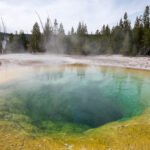Volcanoes of Hawaii visited in 2018
I can’t quite recall the first time I saw floods of lava pouring into the ocean on TV, but I recall my reaction being an instant “Wow!” The venue of this spellbinding display was on the island of Hawaii, alias Big Island, the largest of the eight islands that make up the Hawaiian archipelago in the North Pacific. Globe in my hands, I cast my eyes on the piece of land that occupied barely the size of a pinhead in the vast Pacific Ocean.
The far-flung island, almost the exact antipode of my hometown, appeared so distant and tiny that it quickly fell into oblivion in the fissures of my brain, up until one day the chance arose to witness the mighty battle between two of nature’s elemental forces—fire and water. The memory of a wondrous phenomenon—one visible today when lava from Kīlauea Volcano flows into the ocean along Big Island’s Puna Coast —resurged on the face of my brain’s deep wrinkles, just as the Polynesian islands emerged from the depths of the sea millions of years ago.
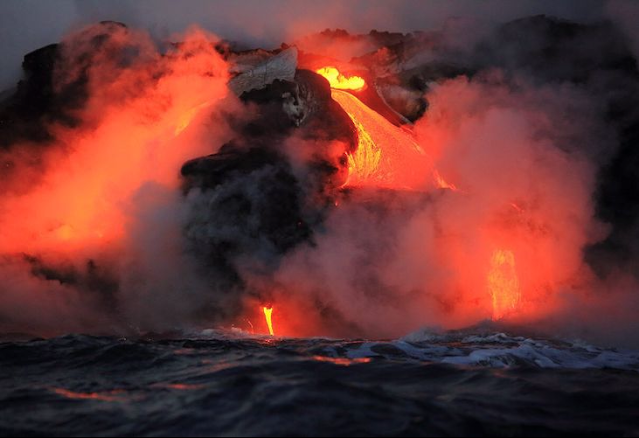
The most profound oceanic depression on the globe, Mariana Trench, lies in the ocean bed of the Pacific that would easily swallow Mount Everest if it were placed at the bottom of the trench. Out of these terrific depths, tremendous lava floods were forced to raise the chains and groups of islands that form Polynesia, plainly suggests the modern story of creation. A thousand years before Western science deduced that the activity of tectonic plates left a series of volcanic islands in its wake, however, the early Polynesians, a stone-age people, mirrored the archipelago’s chronology in their generations-old legends and myths.
Legends and Volcanoes of Hawaii Quick Links
The Birth of Polynesia and Hawaii Islands
In olden times, when there was nothing but sea, an immense bird settled on the waters of the ocean and laid an egg. It soon broke open releasing Mother Earth and Father Sky. At first, the sky rested close upon the earth, causing utter darkness for ages. One day, the sons born in this period of darkness felt the necessity of separating their parents to get more light and eventually crawl out and spread in the vastness of the Pacific. The legend of lifting the sky is ascribed to Maui, one of the Polynesian demigods, who is also believed to fish up from the ocean many islands in the Polynesian Triangle, including the Hawaiian Islands.
Legend has it that Maui was not as skilled a fisherman as his brothers, hence he was often ridiculed and excluded from fishing trips. One day, during a fishing trip with his brothers, a frustrated Maui threw his magic hook into the sea and caught the ocean floor by mistake. Thinking he caught a huge fish, he began to reel his catch. To ensure a firm fishing line, Maui called for his brothers to paddle with all their might against the coming fish.
For two days, they placed enormous strength, drawing the line to its fullest extent. Soon land rose out of the water behind them. Maui told his brothers not to look back or the fish would be lost. One brother did look back causing the line to slack and break. The land stopped rising and lay behind them in islands. So rose the great islands of Hawaii from the depths of the Pacific.

According to various Polynesian legends, Maui raised the sky, fished up the islands, and made the earth inhabitable for his fellow-beings, but it’s Pele, the honored female deity of fire, who shaped the Hawaiian chain. Her wanderlust for far-away lands brought Pele to the Hawaiian group by canoe, ages after the islands were built.
The shifting journey of fire in Hawaii
A happy Pele was living in the presence of her earth mother and sky father, and yet she longed for adventure. So she asked her father to send her away with her unborn egg sister under her arm. Pele set sail in a canoe provided by her oldest brother, the god of sharks, and accompanied by some of their relatives: the gods of whirlwinds, strong current, and moving seas. Pele was carried from land to land by these wise boatmen until at last, she landed on the island Niihau, the most northerly of the Hawaiian group. She looked for a place to dig the fire-pit and make her home.
Pele had a magic digging tool, Paoa. When she struck this down into the earth it made a fire-pit, but Pele could only strike her Paoa in the lowlands near the sea. All her fire-pits were so near the water that the fires she kindled in great explosions of steam and sand drowned by the water and died quickly. So she went from island to island working her way down the chain to the Big Island until at last, she found Kilauea, where she built an enduring palace of fire.
The fire goddess, Pele, legend has it, still resides in Kilauea, and is hailed as the mighty force behind Kilauea’s eruptions. As long as Pele is erupting, the natives say she is hula dancing with her little sister, who was already a teenager by the time Pele had reached Hawaii Island.
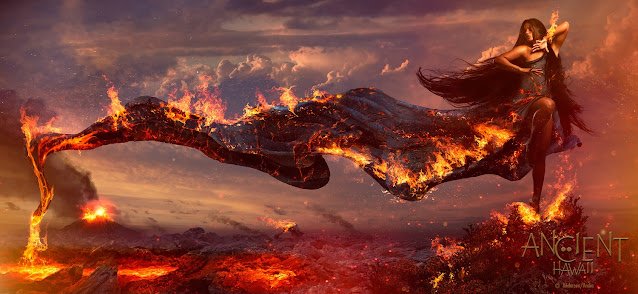
Pele’s journey indeed traces the geological evolution of the islands themselves, beginning with the oldest in the northwest, and ending at the youngest addition of the chain in the southeast. This progression very well corresponds to the modern scientific notion of the age of volcanoes, on account of the shifting volcanic activity.
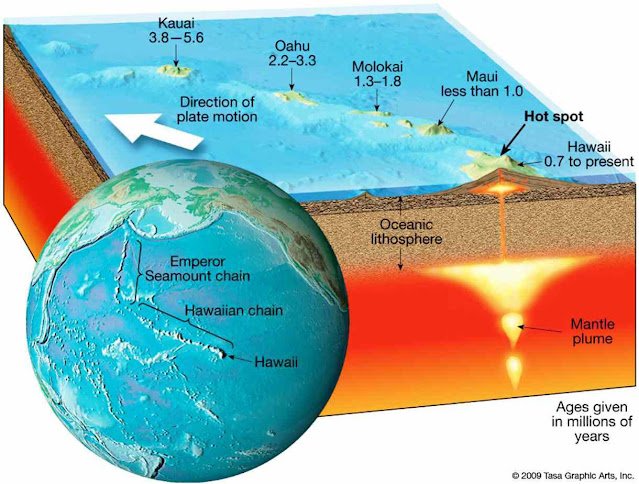
As the Pacific plate moved the hot spot “drawing a line”, the trail of underwater mountains formed over millions of years as if carried along a massive underwater conveyer belt. You can even see where new islands will form in the distant future, and which islands will vanish and submerge in oblivion. So it seems only natural to associate the hot spot Hawaii in particular with Pele, but today science can explain what volcanoes are and how they erupt.
School of Earth and Volcanology: Principal Types of Volcanoes
The word volcano comes from the name Vulcan, named after the Roman god of fire, but I think it should have been named after Pele, something like Pelerine that would sound more feminine! Oh well, back to science: a volcano is simply put an opening on the face of the earth, but not all volcanoes are alike, and they are not always mountains. Here are the three principal types of volcanoes:
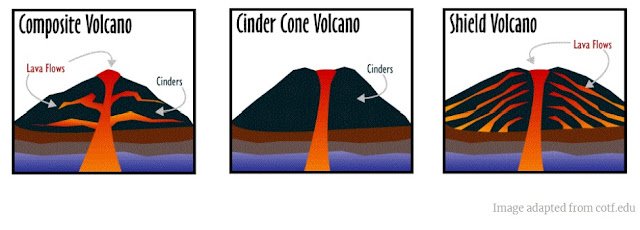
Stratovolcano (or composite volcano) is a conical volcano consisting of layers of solid lava flows mixed with layers of other rock, such as volcanic ash, tephra (volcanic debris), and pumice that form a cone-shaped mountain with steep, smooth, long slopes. Some of the most well-known mountains in the world are composite volcanoes, including Mount Fuji in Japan, Mount Cotopaxi in Ecuador, Mount Vesuvius in Italy, and Mount St. Helens and Mount Rainier in the US.
Cinder cone volcano doesn’t have any horizontal layers and is the simplest type of volcano featuring a steep conical hill of tephra that accumulates around and downwind from the vent. Cinder cone volcanoes are the ones that most people associate with an erupting volcano owing to their cone-shaped peak. One of the most active cinder cone volcanoes is Cerro Negro in Nicaragua, Central America’s youngest volcano born in April 1850.
A shield volcano is a type of volcano built almost entirely of fluid lava vents, which flow out in all directions that form gently sloping, horizontally developed shield-like mountains that can stretch hundreds of kilometers wide. They are named like this because they are broad and flat like a massive warrior’s shield. They almost never have violent eruptions, with lava simply flowing out. Only if water gets into the vent, it’s more likely to cause violent and explosive hydrovolcanic eruptions. Hawaii’s main volcanoes are shield volcanoes, making for a natural laboratory for science. Most of what we know about shield volcanoes today comes from the study of the volcanoes in Hawaii.
The volcanoes of the Big Island of Hawaii
The youngest of the Hawaiian Islands is, in fact, a product of five shield volcanoes that have joined forces over the past one million years to create the Big Island. These volcanoes that comprise the island of Hawaii, from the oldest to the youngest are named: Kohala (inactive), Mauna Kea (dormant), Hualalai (active), Mauna Loa (active), and Kilauea (active). They formed one after another and partially overlap.
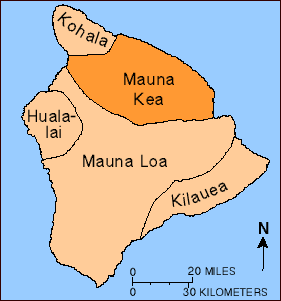
Mauna Kea, thedormant shield volcano,is not only the tallest mountain in the Hawaiian chain but also the tallest sea mountain in the world. Measuring 10,211 m / 33,500 ft in height from base to summit, Mauna Kea is significantly taller than Mt. Everest, though it would still be swallowed by Mariana Trench (-10,994 m)! Don’t you think the symmetry between the tallest sea mountain and the deepest trench in the world is an interesting coincidence?
Anyhow, because the Big Island is so heavy, most of the volcano sinks below the ocean, like an iron ball on a rubber sheet, leaving only 4205 m / 13796 ft above the sea level. Even so, Mauna’ Kea’s summit is still at a pretty high altitude and thanks to stable airflow and dry environment, it’s one of the best places in the world for astronomical observations.
Mauna Loa is the world’s most massive activeshield volcano and the largest single mountain on earth, deceptively covering half of Hawaii Island. Lava from Mauna Loa can reach the sea in less than 24 hours, destroying everything in its path. Mauna Loa has been erupting for over 7,000 years, most recently in 1984.
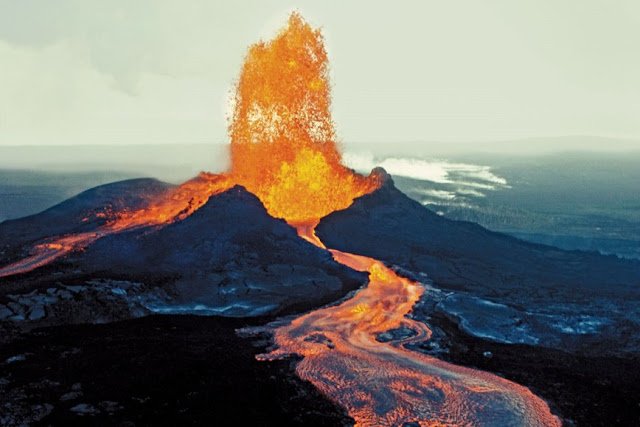
Kilauea, the youngest of the Big Island’s volcanoes, is the world’s most active volcano and has been in an eruptive state since 1983. The latest eruption of the Kilauea started on December 20, 2020, and was still erupting whilst this article was in the works in January 2021.
While Mauna Loa is the greatest mountain, opening doors for the Pele fires from all its sides, Kilauea is the very active Pele crater discharging fire from the very depths of the earth in rivers of lava. Currents of molten lava push their way underneath a continually cooling and hardening surface, and eventually finding an outlet even under the waves of the sea, leaving long tunnels behind. Sometimes when new lava streams through the walls of these caves left ages before, the natives say, ‘Pele has gone to the sea by the hidden path’.
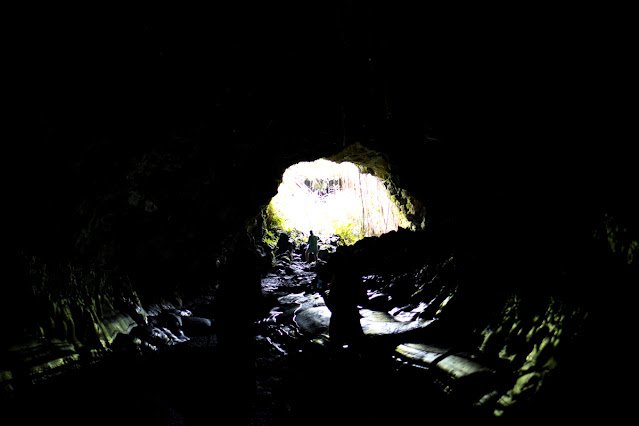
My journey in search of Pele on a Boat Tour
Back in 2018, I went to the Big Island of Hawaii a few months after the river of lava covered the land, eating houses and forests on its way to the ocean. When Pele feels like hula dancing and forces Hawaii Volcanoes National Park to close to the public, it becomes logistically very complicated to get access to the lava. One of the few remaining ways to see lava kissing the ocean is by boat, volcanic activity permitting. Then exactly two weeks after my visit, ocean entries ceased.
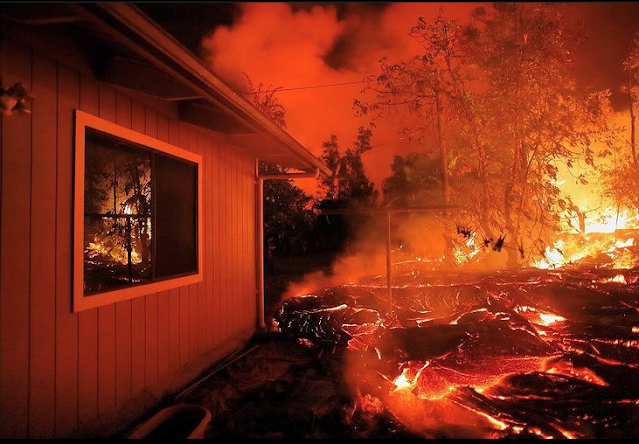
The boat journey was long; the round trip took almost four hours through the rough ocean to spend a few minutes, say a quarter of an hour tops, on a rocky boat trying to photograph and film lava pouring into the water; naturally from a safe distance of 100 yards. Yet still, it was a very intense experience being so close to the lava, to the power of the raging volcanic fires giving birth to new lands with the ocean boiling beneath the boat. A combi ticket for a roller coaster ride, saltwater rafting, and steam sauna in one, what more could you ask for?! Watch it here: https://youtu.be/V0TgiLJtJVU
Bottomline: Volcanoes and Legends of Hawaii
Although the Hawaiian alphabet only has 13 letters –A, E, I, O, U, H, K, L, M, N, P, W and the ‘okina (an apostrophe)– there are as many versions of the Hawaiian legends as there is volcanic black sand in Hawaiʻi. The aforementioned stories were compiled and compressed after reading two collections by William D. Westervelt: Hawaiian Legends of Volcanoes and Legends of Maui, A Demigod of Polynesia. However, I took the liberty of letting my imagination recount its own version of the legends in this article.
From arid deserts to lush forests, from towering cliffs to sandy beaches, from the snow-capped peaks to volcanic fires, you may want to flip through the innumerable Hawaiian legends attached to many of its extremely diverse landscapes for yourself.
Who knows, one day when you visit the Hawaiian waters, you might swim in your memories of these stories in search of the face of the Pele in the bends of a bubbling lava flow, or perhaps you might find yourself gazing at the remnants of blood sprinkles of serpents on the starry sky.
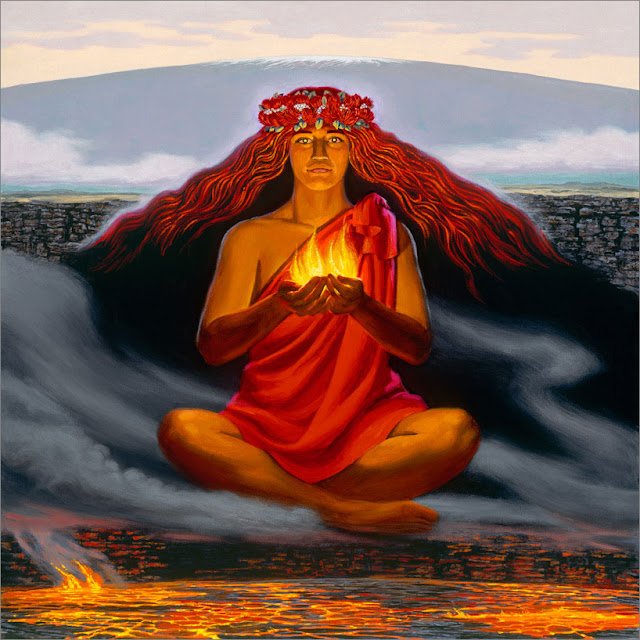
Browse all our USA posts here at this link!


